Family : Verbenaceae

Text © Pietro Puccio

English translation by Mario Beltramini
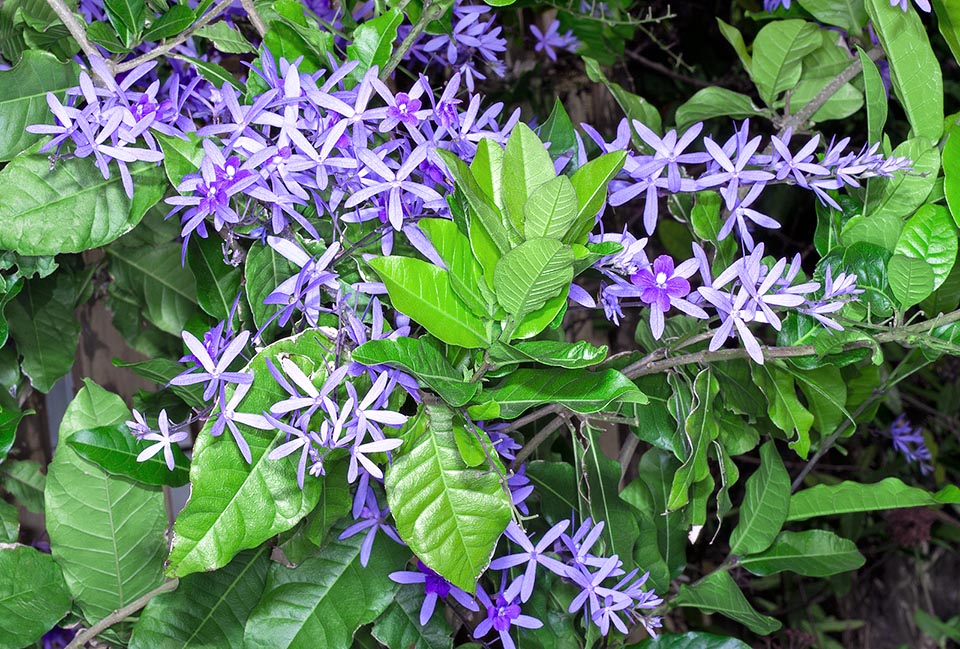
The Petrea volubilis is a sarmentose or evergreen woody climber native to tropical America © Giuseppe Mazza
The species is native to Antigua and Barbuda, Belize, Bolivia, Brazil, Colombia, Costa Rica, Cuba, Dominican Republic, Ecuador, El Salvador, French Guyana, Guadalupe, Guatemala, Guyana, Haiti, Honduras, Jamaica, Mexico (Campeche, Chiapas, Coahuila, Guerrero, Hidalgo, Mexico, Michoacan, Oaxaca, Puebla, Queretaro, Quintana Roo, San Luis Potosi, Tabasco, Tamaulipas, Veracruz and Yucatan), Nicaragua, Panama, Paraguay, Peru, Puerto Rico, Suriname, Trinidad and Tobago, U.S.A. (Florida) and Venezuela where it grows in the seasonal forests along water streams, clearings and on rocky outcrops, from the sea level up to about 1900 m of altitude.
The genus was dedicated to the English botanist and collector Robert James Petre (1713-1742) who introduced in Europe numerous tropical species; the specific name is the Latin adjective “volubilis, e” = that wraps rapidly, that turns around, with reference to the voluble stems.
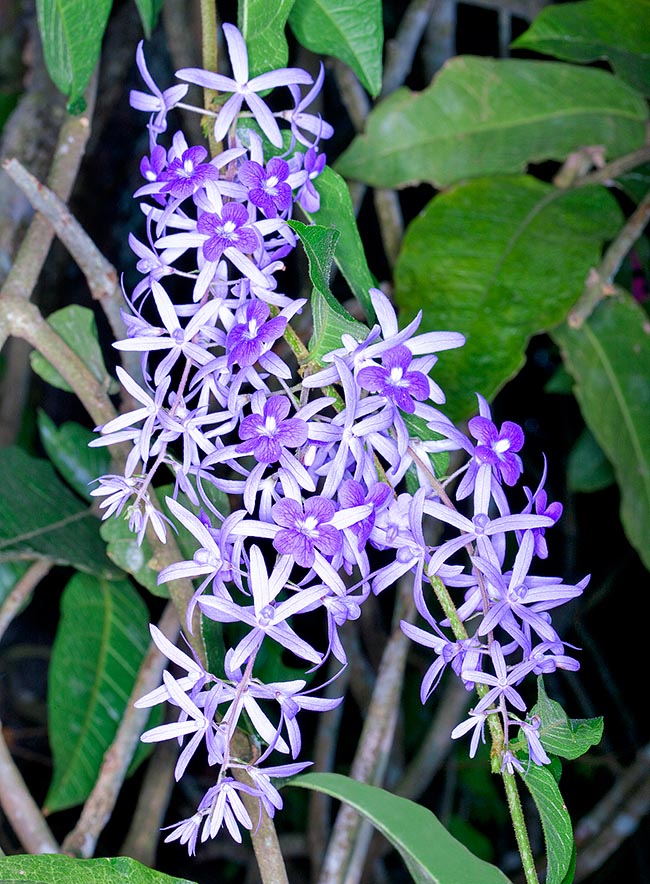
The stems can be 10 m long and of 10 cm of diameter at the base © Giuseppe Mazza
Common names: purple-wreath, queen wreath, queen’s-wreath, sandpaper (English); capela-de-viúva, cipó-de-são-Miguel, flor-de-São-Jose, flor-de-São-Miguel, flor-de-viuva, petréia, touca-de-viúva, viuvinha (Brazil); chaparro (Colombia); choreque (Costa Rica); mayapi (French Guyana); chaparro, flor de diablo, flor de Jesus, manto del nazareno, sombrerito (Honduras); adolfina, flor de Jesus, manto de Jesus (El Salvador); bejuco de caballo, bejuco de lija, bejuco de soltero, bejuco lava plato, bejuco tieso, bejuquillo, capitan lila, corona de reina, corona púrpura, cuero de sapo, espuela de caballero, flor de dios, flor de san miguel, nazareno, palo tostado, piocha vieja, raspa sombrero, ramo de reina, santa rita, túnica de cristo, yo’och oop’tsiimim (Mexico); machigua (Nicaragua); bejuco de ajo (Panama); bejuco de mayo, bejuco de palo, flor de mayo, moradito, nasareno, santa lucia, serae serae, tostadito (Venezuela).
The Petrea volubilis L. (1753) is a shrub, sarmentose or evergreen woody climber, or semi-deciduous, very variable, with stems that can reach the length of 10 m and 10 cm of diameter at the base.
The leaves, on a 1-1,6 cm long petiole, are simple, opposite, oblong-elliptic with entire margin and acute apex, 5-20 cm long and 3-10 cm broad,wrinkled to the touch, initially of pale green colour with pinky shades, then dark green above, paler below.
Axillar racemose inflorescences at the apex of the branches, arcuate, up to 60 cm long, carrying, on a 0,6-0,8 cm long pedicel, a multitude of bisexual flowers of 3-5 cm of diameter.
Petaloid calyx with 5 oblong lobes having acute apex, 1,5-2,5 cm long, and 0,5-1 cm broad, of pale blue colour, rarely white.
Hypocrateriform corolla of blue or lilac colour, more or less intense, or white like the calyx, of about 1,2 cm of diameter, with 5 rounded lobes of which 4 similar and the fore one slightly bigger with white spot at the base; the corolla lasts only a some days, but the ornamental effect continues thanks to the calyx persisting for long time after its fall.
Didynamous stamens (stamens arranged in two pairs, one longer than the other), oblong inferior ovary, bilocular, and style, about 3 mm long, with the stigma just under the anthers.
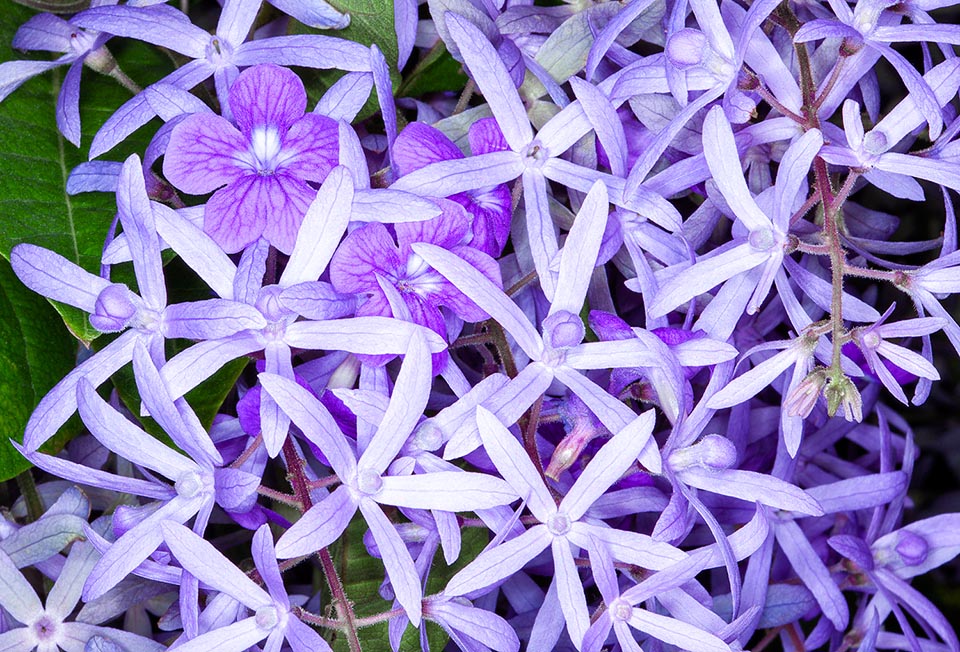
Axillar racemose inflorescences at the apex of the branches, arcuate, up to 60 cm long. The calyx has 5 oblong lobes with acute apex, of pale blue colour. The 5 lobes corolla can be blue or lilac, more or less intense. It lasts only some days, but the ornamental effect continues due to the calyx that persists long time on the plant after its fall © Giuseppe Mazza
Drupaceous fruits with woody endocarp formed by 1-2 ovoid kernels, 1-2 mm long, containing only one seed; the fruits are wholly enclosed by the calyx, whose lobes get rigid when ripen, that favours its dispersion through the wind or the water, by floating.
It propagates by seed, previously maintained in water for 1-2 days, in porous and draining substratum maintained humid at the temperature of 24-28 °C, with germination times of 1-2 months, but more frequently through woody cutting, layering and the basal suckers eventually produced.
The most diffused species of the genus in nature and the most cultivated due to its remarkable and ornamental characteristics, the fast growth and the abundant blooming, that may repeat more times during the year, that renders it one of the most spectaculars climbers in absolute.
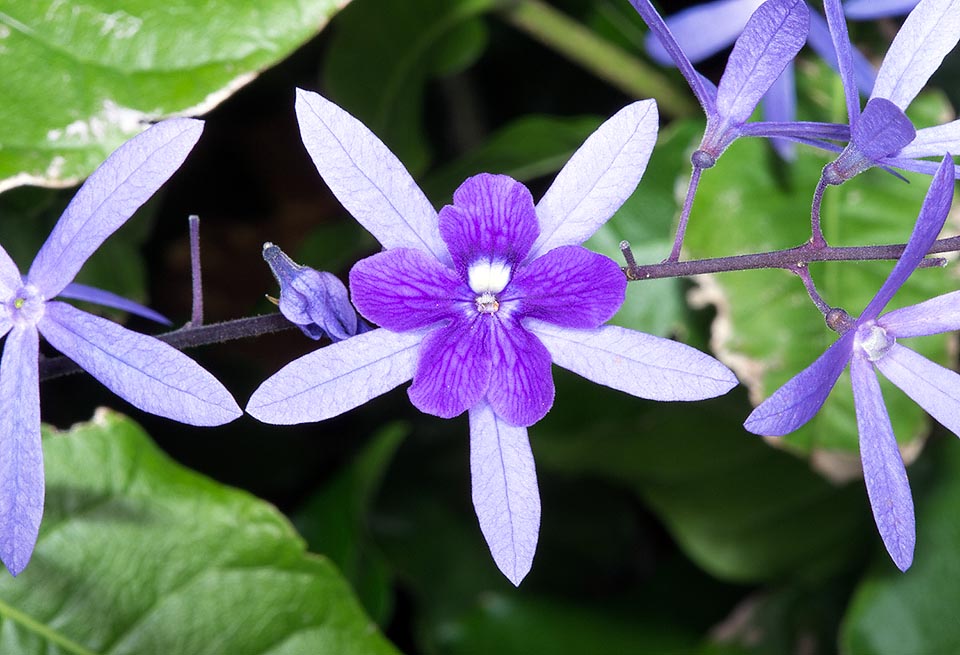
Close up of a flower. The fore lobe of the corolla, slightly bigger, displays one white spot at the base. Easy cultivation in the tropics; possible in luminous inner spaces © Giuseppe Mazza
It is cultivable in the tropical, subtropical and mildest warm temperate regions, where it can resist exceptional values of temperature up to -2 °C for a short period.
Vigorous plant that can be made climbing on the trees, on robust trellises or pergolas or, with appropriate pruning, grown as shrub; requires full sun or at the most, a slight shade and fertile draining soils. It displays a good resistance to the saltiness, therefore can be employed in gardens close to the sea.
Young plants require regular watering during the growth period, well rooted they may resist dry periods, useful are the fertilizations with balanced products in spring-summer.
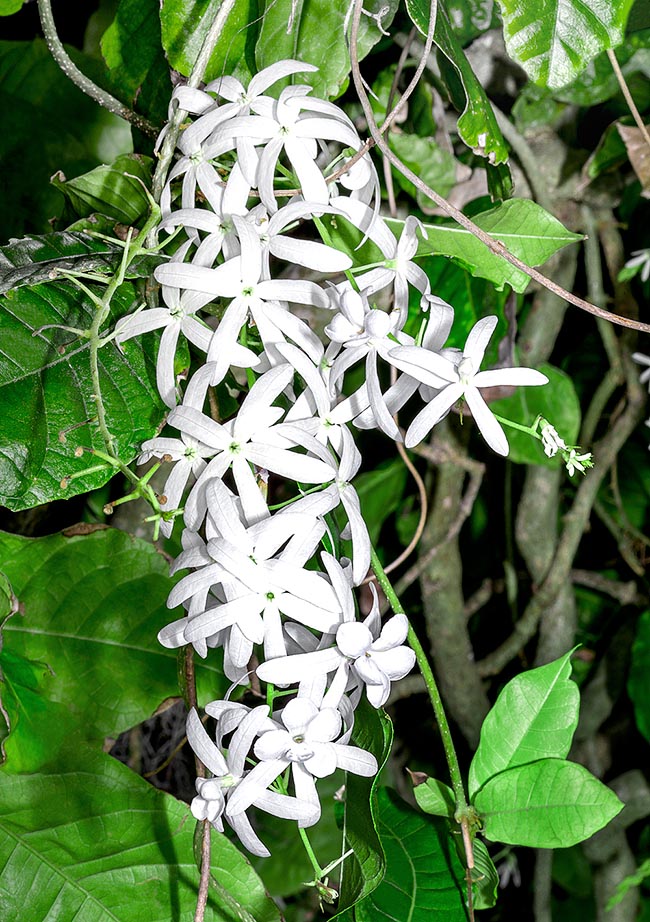
As at times occurs in the world of flowers, also a depigmented form does exist with white corollas and calyces © Giuseppe Mazza
Where the climate does not allow its cultivation permanently in open air, it may be cultivated in pot to be sheltered during the coldest months in particularly luminous environment, with temperatures preferably not under the 16 °C.
Synonyms: Petrea arborea Kunth (1818); Petrea racemosa Nees (1821); Petrea erecta G.Lodd. (1830); Petrea mexicana Willd. ex Cham. (1832); Petrea subserrata Cham. (1832); Petrea volubilis var. mexicana Cham. (1832); Petrea stapeliae Paxton (1838); Petrea ovata M.Martens & Galeotti (1844); Petrea kohautiana C.Presl (1845); Petrea retusa C.Presl (1845); Petrea serrata C.Presl (1845); Petrea aspera Turcz. (1863): Petrea vincentina Turcz. (1863); Petrea subserrata Bárcena (1877); Petrea fragrantissima Rusby (1927); Petrea volubilis var. alba G.F.Freeman & W.G.Freeman (1928); Petrea arborea f. albiflora Standl. (1932); Petrea volubilis var. albiflora (Standl.) Moldenke (1937); Petrea amazonica Moldenke (1938); Petrea arborea var. broadwayi Moldenke (1938); Petrea arborescens Archer ex Moldenke (1938); Petrea atrocoerulea Moldenke (1938); Petrea colombiana Moldenke (1938); Petrea kohautiana var. anomala Moldenke (1938); Petrea nitidula Moldenke (1938); Petrea riparia Moldenke (1938); Petrea rivularis Moldenke (1938); Petrea swallenii Moldenke (1938); Petrea volubilis f. albiflora (Standl.) Standl. (1938); Petrea volubilis var. pubescens Moldenke (1938); Petrea racemosa var. alba Kuhlm. ex Moldenke (1961); Petrea aspera f. albiflora Moldenke (1969); Petrea kohautiana var. pilosula Moldenke (1974); Petrea arborea f. broadwayi (Moldenke) Moldenke (1979); Petrea kohautiana f. alba (G.F.Freeman & W.G.Freeman) Moldenke (1979); Petrea racemosa f. alba (Kuhlm. ex Moldenke) Moldenke (1979); Petrea volubilis f. pubescens (Moldenke) Moldenke (1979).
→ To appreciate the biodiversity within VERBENACEAE family please click here.
